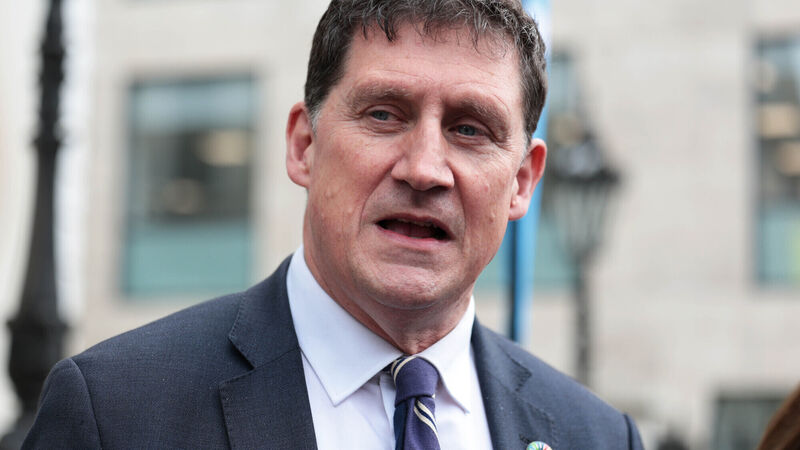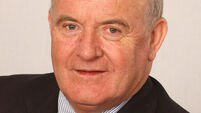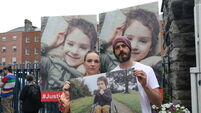Irish Examiner view: The Green Party's battle with wants and needs

Last week, Green Party leader Eamon Ryan wooed Cork voters by revealing the next phase of the Cork Area Commuter Rail Programme, which will not only see battery electric trains running on new high-frequency urban services, but the delivery of eight new stations along the Cobh, Mallow, and Midleton lines. Picture: Leah Farrell/RollingNews.ie
Although recent polling suggests that the Green Party will struggle to toe-hold anything more than 5% of the vote in the next general election, the party leadership has been busy trying to remind the public about its relevance in Government and its importance in shaping a climate-friendly future for the country.
Last week, party leader Eamon Ryan wooed Cork voters by revealing the next phase of the Cork Area Commuter Rail Programme, which will not only see battery electric trains running on new high-frequency urban services, but the delivery of eight new stations along the Cobh, Mallow, and Midleton lines.
Yesterday, he unveiled new measures aimed at tackling the near absence of a coherent electric vehicle charging infrastructure across Ireland, including a pool of high-powered chargers every 60km along our motorway network, as well as home and apartment charging, destination charging, and residential neighbourhood charging.
Developing Cork’s commuter rail system has been a Green Party aim for some considerable time and, despite an ongoing row over the routing of the proposed inner-city network, the plans represent a concrete step forward.
So too the aims for a national EV charging network, especially at a time when there has been consecutive months in which electric car sales have fallen dramatically because of consumer doubts about the viability of buying such vehicles.
For many uncommitted voters, including those wishing to see Government implement many more climate-friendly policies, a big sticking point against voting for Mr Ryan’s party has been its unwillingness to commit to certain strategic infrastructure developments such as the M20 motorway between Limerick and Cork and the Galway ring road.
Voters will have noted that while the Greens — and particularly Mr Ryan — have not blocked such important roads, the projects have not advanced quickly enough.
While the party and its leader have obvious projects they need to see across the line in case the electorate does not find them as attractive in the next election as they did in the last, it might be advantageous for their nationwide popularity if they were seen to be pro-active on essential infrastructure.
Of course the Greens have their own agenda — climate change must be at the heart of any future government’s formation — and need to be seen to be sticking to their guns or risk accusations of hypocrisy. But they also crave votes and, as such, have to be open to compromise and accommodation for projects for which there is a screaming need.
Certainly there is a ‘build it and they will come’ vibe about new commuter rail services such as those in Cork or the extension of Dublin’s Dart line to Drogheda, but the reality of politics means they have grasp certain nettles they might not idealistically want to touch.
Whatever controversies the forthcoming European and local elections might throw up in the coming 10 days, it is pleasing to note that, in one particular aspect, the polls will break one very notable record.
The number of female candidates has reached an unprecedented level, and that is a welcome state of affairs.
In the local elections, there will be some 655 women standing in every local electoral area bar three — representing 32% of all candidates standing. This compares with the 561 who stood in the 2019 elections, along with the 440 in 2014.
It is vital for the legitimacy of all elections — not to mention for the State as a whole — for female political representation to be strong, and it is a very positive thing that women are increasingly finding their feet and their voice at every level of Irish politics.
Despite the specific identification of the importance of women’s roles in Irish society in the 1916 Proclamation of an Irish Republic, women have not been well served in this country over the last 100 years — electorally or socially.
Thankfully, that tide seems to be turning at last.
The weekend past was full of sporting highlights: The fantastic Champions Cup final between Leinster and Toulouse; Manchester United’s unexpected redemption in the FA Cup final; Limerick and Clare qualifying for the Munster final; Charles Leclerc’s flag-to-flag win at the Monaco Grand Prix.
Each of these gave us moments of brilliance, but the death on Saturday of American golfer Grayson Murray, 30, by suicide was a sharp and grim reminder that the lives of top sports personalities are not all about the joys of success or the pleasure of beating the odds.
The PGA Tour was rocked by the news of Greyson’s passing, especially so in a year in which he seemed to be fulfilling the great things predicted for a talent such as his. It was only in January that he won his second tour event in Hawaii.
He spoke after that win about his struggles with depression and alcohol dependency and received widespread acclaim for his honesty and openness. The statement from his parents, Eric and Terry, on Sunday night asking people to honour his memory simply by “being kind to each other” was a wrenching testament to the depth of the tragedy.
We are well versed in this country in the after-effects of suicide, even among high-profile sports stars, but Greyson Murray’s passing was particularly shocking for many people as this was a man whose life appeared to be on an ever-upward trajectory.
We know life never is what it seems (or in many cases what it is painted to be in the media, social or otherwise) but a tragedy such as this only highlights the necessity for us to be conscious of the need to help and assist those requiring it.
















